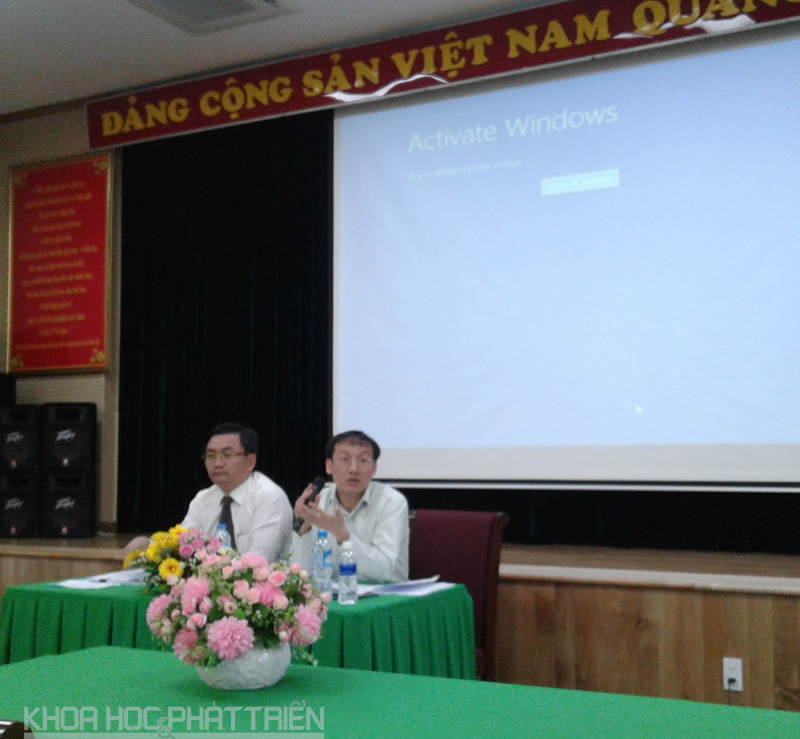Encouragement for Public Scientific and Technological Organizations to Increase Autonomy
The autonomy rights of science and technology (S&T) organizations are regulated according to each type and encouraged so that S&T organizations strive to gain more autonomy rights.
This is the information provided by Mr. Dinh Viet Bach – Head of the Organization - Staffing Department, Organization and Personnel Department, Ministry of Science and Technology at the Workshop on Guidance for the Implementation of Decree 54/2016/ND-CP dated June 14, 2016, of the Government of Vietnam regulating the self-management mechanism of public science and technology organizations (referred to as Decree 54) and the guiding circulars issued by the Ministry of Science and Technology on November 22 in Ho Chi Minh City.
Decree 54 defines the autonomy rights of public science and technology organizations, including financial autonomy, task performance, organizational structure, personnel, management, and use of assets. The scientific and technological organizations will be classified into four types based on their level of self-financing for recurrent and investment expenditures. These types are: organizations fully covering recurrent and investment expenditures (Type 1); organizations fully covering recurrent expenditures (Type 2); organizations partially covering their recurrent expenditures (Type 3); and organizations for which the state covers recurrent expenditures (Type 4).

To be specific, for Types 1 and 2, they have many autonomy rights such as deciding personnel, having the right to establish, organize, and dissolve new units; assets are valued by competent authorities for management according to enterprise capital allocation mechanisms; proactively using the financial resources allocated for autonomy, etc.
For Types 3 and 4, the autonomy rights are more limited compared to Types 1 and 2. Regarding personnel, these two types must develop job positions and structure public employees by professional titles, which must be approved by competent authorities. Additionally, Type 4 is not allowed to use state assets for leasing or other business activities, etc.
"The different provisions aim to encourage public science and technology organizations to strive from Types 3 and 4 to Types 1 and 2 to enjoy more autonomy rights," emphasized Mr. Bach.
To implement Decree 54 and Decree 16/2015/ND-CP dated February 14, 2015, of the Government of Vietnam regulating the self-management mechanism of public service providers, in 2017, the Ministry of Finance issued two circulars: Circular 01/2017/TT-BTC, detailing some provisions of Decree 54 and Circular 90/2017/TT-BTC, stipulating the implementation of the financial autonomy mechanism for public science and technology organizations.
Mr. Dinh Viet Bach stated that public organizations wishing to determine their classification as a public science and technology organization should base it on revenue and expenditure estimates and the results of revenue and expenditure implementation in previous years. The level of self-financing for recurrent expenditures (%) is calculated by Total non-budget revenue/Total recurrent expenditure x 100%. If this number is greater than 100%, the organization is classified as Type 1; equal to or greater than 100% as Type 2; from above 10% to below 100% as Type 3; and below 10% as Type 4.
A new and flexible aspect for public science and technology organizations in Circular 90 is allowing them to report, assess the implementation status of the self-management mechanism over 3 years, and propose a self-management plan for the next 3 years for competent authorities to review and approve. In those 3 years, if any organization undergoes changes in functions, tasks, or revenue variations that alter the level of self-financing, they can develop a new plan for re-approval by competent authorities to fit the actual situation.
At the Workshop, some remaining issues were discussed by delegates, such as recruiting and appointing officers; year-end financial settlements; asset depreciation calculation; tax policies; salary expenditure; and redeveloping plans according to Decree 54, etc. Some delegates' questions were explained and specifically guided by Mr. Bach.
Mr. Pham Xuan Da – Director of the Southern Affairs Department of the Ministry of Science and Technology, believed that implementing Decree 54 in practice would encounter difficulties and challenges.
"Public science and technology organizations need to make written recommendations to the Ministry of Science and Technology so that the Ministry can consolidate and submit them to the Ministry of Finance, the Ministry of Home Affairs, and the Government of Vietnam to address these difficulties and challenges," suggested Mr. Da.
Source: Science and Development
- Number of deputy directors of departments in Vietnam in accordance with Decree 45/2025/ND-CP
- Cases ineligible for pardon in Vietnam in 2025
- Decree 50/2025 amending Decree 151/2017 on the management of public assets in Vietnam
- Circular 07/2025 amending Circular 02/2022 on the Law on Environmental Protection in Vietnam
- Adjustment to the organizational structure of the Ministry of Health of Vietnam: Certain agencies are no longer listed in the organizational structure
- Vietnam aims to welcome 22-23 million international tourists in Vietnam in 2025
-

- Notable new policies of Vietnam effective as of ...
- 16:26, 11/04/2025
-
.Medium.png)
- Notable documents of Vietnam in the previous week ...
- 16:21, 11/04/2025
-
.Medium.png)
- Notable documents of Vietnam in the previous week ...
- 16:11, 02/04/2025
-
.Medium.png)
- Notable new policies of Vietnam to be effective ...
- 16:04, 02/04/2025
-
.Medium.png)
- Notable new policies of Vietnam effective from ...
- 14:51, 21/03/2025
 Article table of contents
Article table of contents
